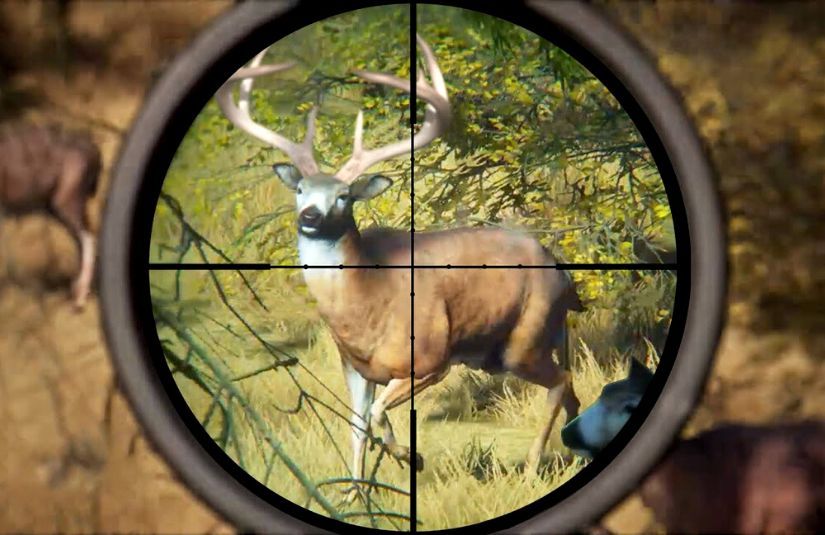Know How Much Wind Is Too Much For Deer Hunting
In order to bag the buck of your dreams, you'll need to understand how wind speed and direction affect deer behavior. In this blog post, you'll learn how much wind is too much for deer hunting & how changes in the wind can make deer hunting difficult, and what you can do to have an advantage.
Are you looking to bag the buck of your dreams?
Understanding how wind speed and direction affect deer behavior is a key to success while deer hunting when it's windy. In this blog post, we will discuss how wind affects deer movement and give you tips on how to use this information to your advantage.
Changes in the wind can make deer skittish and deer movement during windy conditions make it difficult to hunt them. Luckily, we have all the information you need right here in this blog post!
Whether you hunt from your climbing treestand or love waiting inside your ground blind, you need to understand the correlation between wind and deer movements. Read our blog post to know how much wind is actually too much for deer hunting!
How Does Wind Effect Deer Movement
Whitetail deer (or in fact most deer) are creatures of habit. They have specific home ranges where they feel comfortable feeding and bedding. Because of this, deer are more likely to move when the weather changes.
Wind can play a big role in deer movement. Deer move when it's windy and the direction and speed of the wind can determine where deer will go and when they will be most active.
Deer Movements in Wind
Deer use their senses to help them orient themselves in their environment. One of the most important senses for deer is their sense of smell.
Deer have a keen sense of smell which they use to detect danger, find food, and communicate with other deer. The direction and speed of the wind can have a big impact on a deer’s sense of smell.
Direction of Wind
If the wind is blowing toward a deer, the deer will be able to smell anything that is downwind of it. If the wind is blowing away from a deer, the deer will not be able to smell anything that is upwind of it.
Speed of Wind
The speed of the wind also affects a deer’s sense of smell. A slow wind allows for more scent molecules to reach a deer’s nose than high winds. This is why you often see deer moving around more when it is calm outside as opposed to when it is windy.
Also, check out our article on the Best Hunting Pants.
Are Deer Active When it's windy: Studies Of Correlation Between Wind And Deer Movement
'Do deer travel on windy days?' This simple question raised by many intrigued many thinkers, ecologists, and hunters alike for decades. There have been several research studies conducted on how wind speed and direction affect deer movement.
These studies confirm what many hunters already know: that deer move when it's windy but windspeed and direction play a big role in their movement patterns. And, varying speeds affect the movements of male and female deer differently.
1. A study by PennState University, College of Agricultural Sciences ( Click to Learn More), shows that:
- Deer movements of male deer are affected significantly more by winds.
- Deer movement during high winds can oftentimes be erratic and a strong breeze of speed 15mph or more will significantly increase deer movements.

2. In another study by Jamie Goethlich it was shown that the movements of deer due to wind speed and direction, will also change according to the time of the day and whether it is pre-breeding or breeding, or post-breeding season. (read his paper 'Effects of Abiotic Factors on White-tailed Deer Activity in South Carolina' )
How to use wind speed and direction to your advantage while deer hunting
If you are hunting deer, it is important to be aware of how wind speed and direction can affect deer movement. By understanding how the wind affects a deer’s sense of smell, you can increase your chances of success when hunting.
Here are some general tips:
If the wind is blowing towards you, stay downwind of where you think the deer will be so that they cannot catch your scent
If the wind is blowing away from you, set up downwind of where you think the deer will be so that they cannot catch your scent
Be aware that a calm day may mean that deer are moving around more because they can detect scents better than on a windy day.
How Wind Has Affected Deer Hunting in the Past
Over the years, hunters have had to adapt to the changing environment to be successful. One of the most significant changes has been the wind. Hunters often use wind speed and direction to their advantage while deer hunting.
- By shooting into the wind, hunters can ensure that their arrows will travel a greater distance and have a higher chance of hitting their target.
- Additionally, the wind can help to mask a hunter's scent, making it less likely that the deer will be alerted to their presence if the wind direction is properly worked out before setting up hunting blinds or stands.
However, in recent years, advances in hunting equipment have made it easier for hunters to contend with the wind. Hunters can now use rangefinders and GPS units or even specially designed hunting watches to more accurately estimate distances and plot their course.
They also have scent-repellent clothing and high-tech blinds, hunters no longer have to rely on the wind direction to remain undetected. As a result, they can hunt in a wider range of conditions and are less likely to be affected by the wind. This has made hunting a more accessible and successful activity for many people.
However, the main problem has remained the same, deers move quite frequently and erratically with high wind speeds, making it difficult to hunt and there is nothing hunters can do about this. So, even today when hunters are asked the question 'is wind good for deer hunting?', they find it difficult to answer in simple terms.

Also, check out our article on Hunting Plan
Frequently Asked Questions
It's no secret that deer movements are greatly affected by wind speeds.
But what is the best way to use this information when hunting?
Our team of experts has tried to answer all of the questions hunters have about wind speeds and deer movements. By understanding how deer react to changing wind conditions, you can put yourself in a better position to take down your next buck.
How does wind direction affect deer movement?
Deer tend to travel into the wind, so they can smell potential predators. If you're downwind from a deer, they will likely scent you long before you see them.
For this reason, it's important to pay attention to the direction of the wind and position yourself accordingly. If you can get upwind of a deer, you'll have a much better chance of getting close enough for a shot.
How much wind is too much for deer hunting?
In general, deer are most active when the wind is between five and ten miles per hour. This is because they feel more comfortable moving around when there's a moderate or light breeze blowing through their environment. If the wind is too strong, it can be difficult for them to smell predators or find food.
On the other hand, if the wind is too weak, they may not be able to detect potential dangers. Therefore, you should aim to hunt when the wind is blowing at a moderate speed.
By understanding how wind speed and direction affect deer behavior, you can increase your chances of success while hunting. Pay attention to the conditions on your next hunt, and use this information to your advantage!
Do bucks move when it's windy?
Yes. Bucks will move when it's windy to avoid being seen by predators or to get a better view of their surroundings. The blowing leaves and grass can also help camouflage them from predators.
But it will also depend on the speed and direction of the wind as well and their movement can be quite erratic.
Is wind good for deer hunting?
There is no simple answer to this question as it depends on the specific situation. In general, deer move when it's windy, and a mild wind (of not more than 15mph) can be advantageous for deer hunting as it can help to cover your scent and mask your movement. It can also help to "cool" the air around you, which can be appealing to deer.
However, wind can also work against you by blowing your scent away from the deer or causing them to become spooked. Also, deer movement in heavy wind can be very erratic making it difficult for hunting. Ultimately, it's important to use your best judgment and adjust your strategy accordingly depending on the conditions.
Should I hunt when it's windy?
It depends on what you're hunting. Larger games, like deer or elk, can sense your presence much more easily when the wind is blowing, making it more difficult to get close to them. Smaller games, like rabbits or birds, are less likely to hear or smell you when the wind is blowing. In general, though, it's better to avoid hunting when it's very windy.
What are some tips you have for deer hunting in windy weather?
Deer hunting in heavy wind is challenging as it can make it more difficult for hunters to remain stealthy and for deer to pick up on the hunter's scent. Here are a few tips for hunting deer in windy weather:
1. Stay downwind of feeding areas. If you can find a spot where the wind is blowing towards a known feeding area, you'll have a good chance of intercepting deer as they come in to feed.
2. Make sure to adjust your calling strategy depending on the wind direction. If the wind is blowing towards you, try to use loud calls that will carry further. If the wind is blowing away from you, use softer calls that won't carry as far.
3. Use a ground blind with scent blocking if possible to help conceal your movements and scent from the deer. Avoid using tree stands in very windy conditions.
4. Make sure you have dressed appropriately for the occasion. Avoid using excess scents or attractants that will only be blown away in the wind.
5. Try to position yourself downwind of where you think the deer are going to be browsing. This way, when they get close, you'll be able to take advantage of the wind direction and drift towards them undetected.
6. Choose your weapon properly. It is difficult for bow hunters to get accurate shots in very windy conditions. But if you like your bow, choose a proper broadhead, a 2-bladed broadhead should be a great choice.
7. Windy conditions can make it more difficult to hunt, so it may be necessary to be more patient and wait for the right opportunity.
Final Thoughts on How Much Wind Is Too Much For Deer Hunting
To be successful at deer hunting when it's windy, it is important to understand how wind direction and speed affect the movement of deer. By positioning yourself correctly with the wind, you can minimize your scent and increase your chances of getting a kill.
The ideal wind speed for deer hunting is between 5-10 mph, and they are most active when the wind is blowing moderately. With this information in mind, use it the next time you go out hunting to best take advantage of the current conditions!
And when you are in the field, be sure to have the best hunting optics that will help you estimate your target distance and also plan your shots correctly for a successful hunt. Also, make sure you are well prepared in advance and have some idea about the science behind deer hunting, instead of just being drowned under hunting pressure, and racing against time to bag that buck!
Happy hunting!
Check out some of our top choices in hunting optical devices:

Check out some of our other articles :





